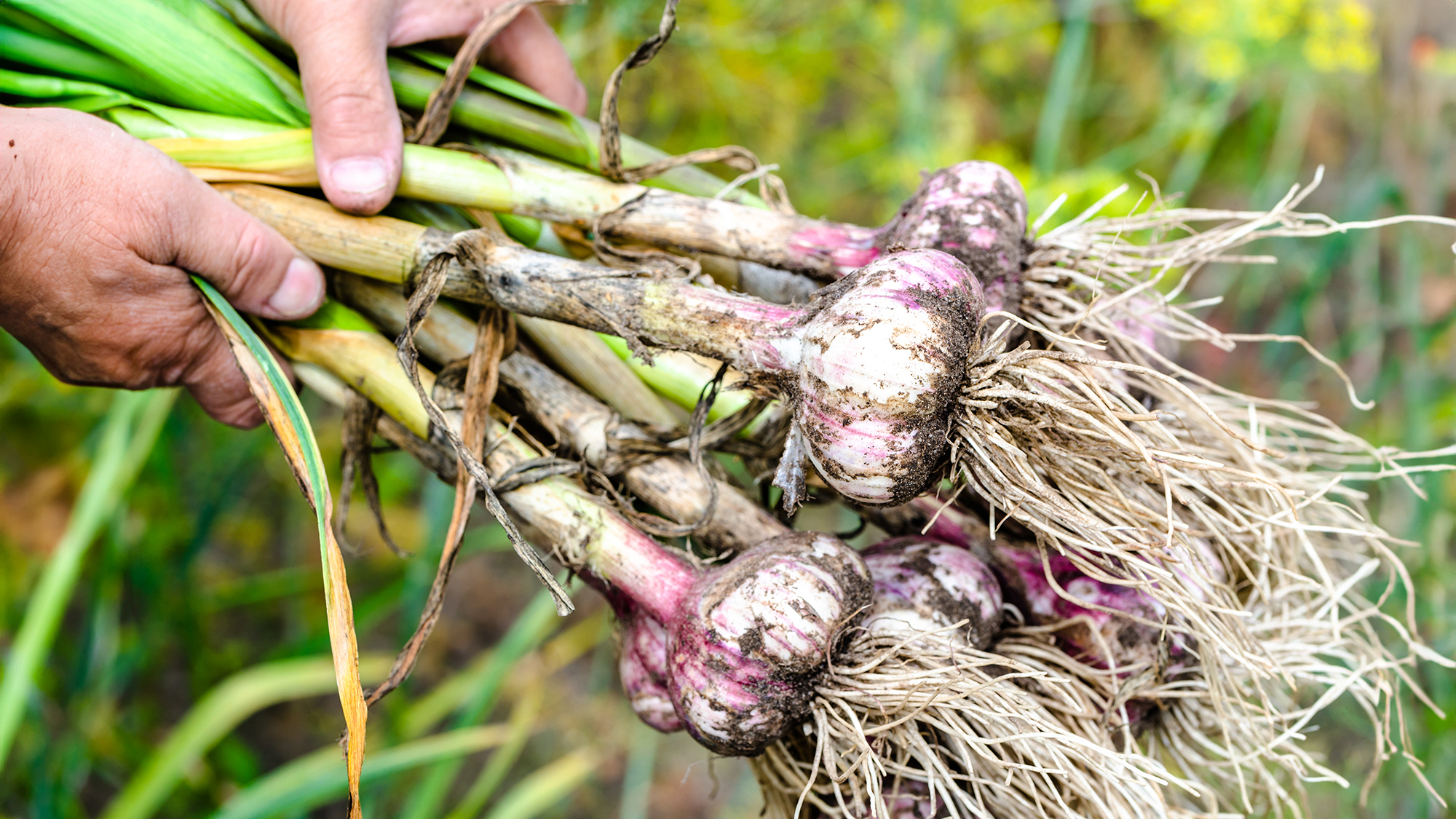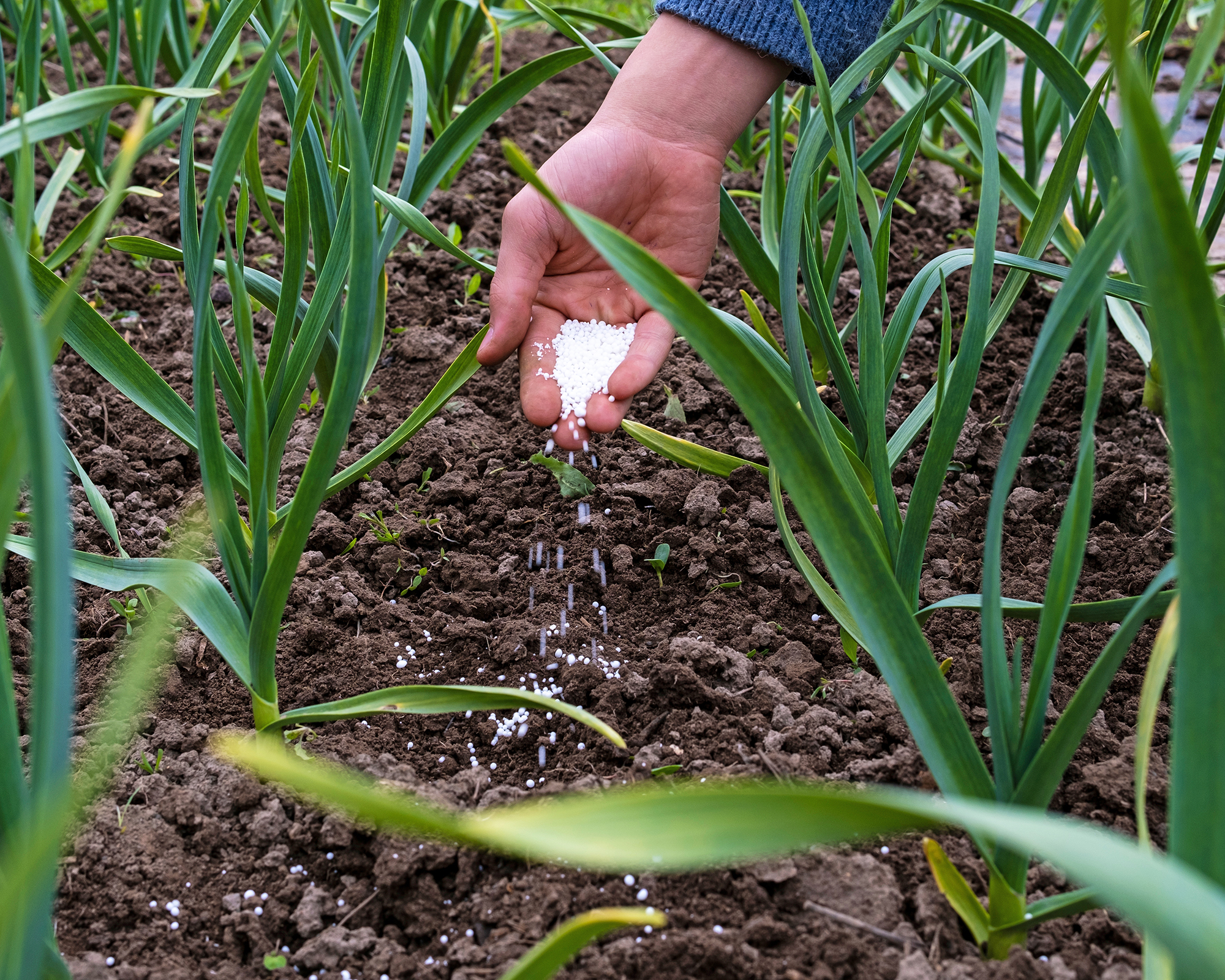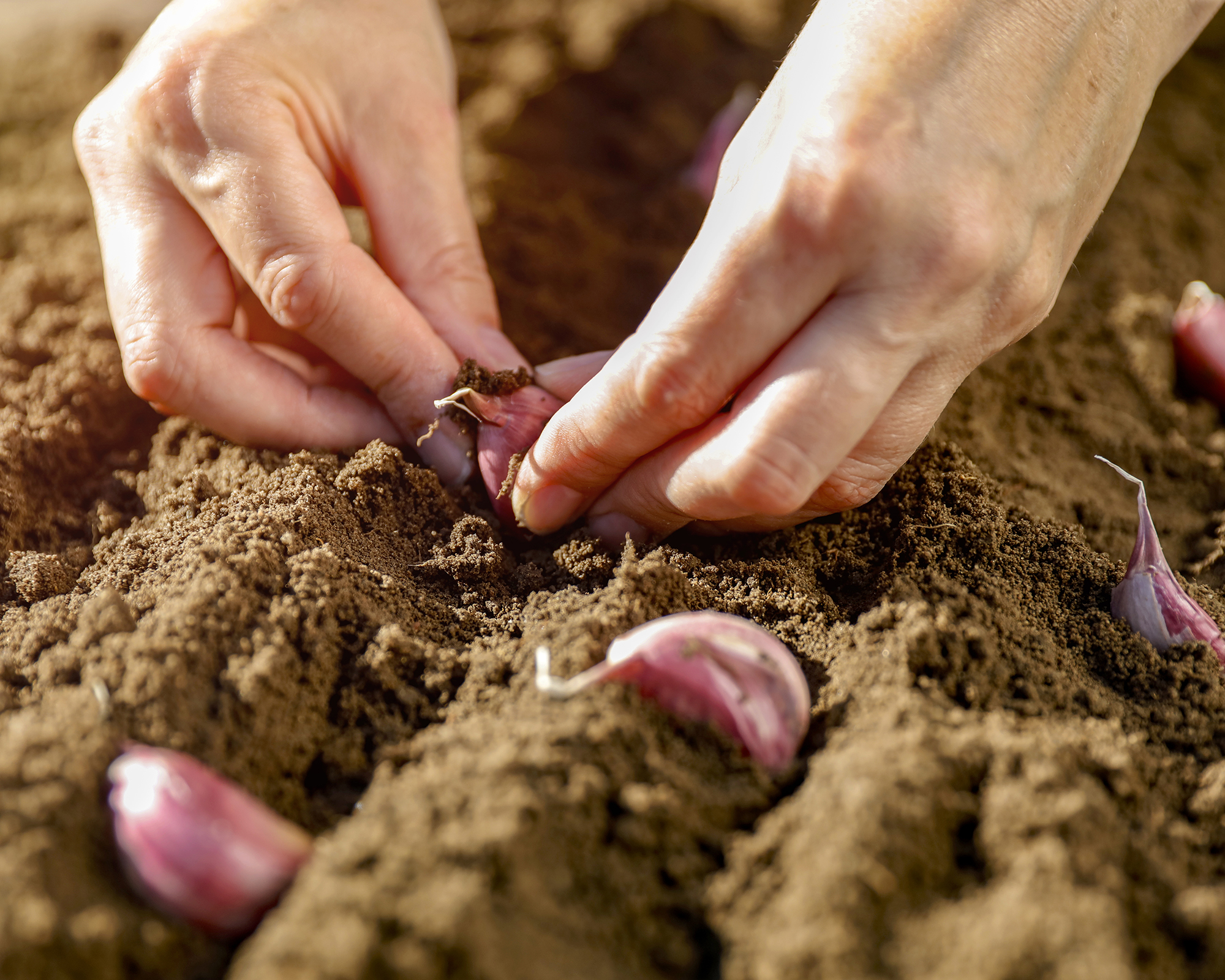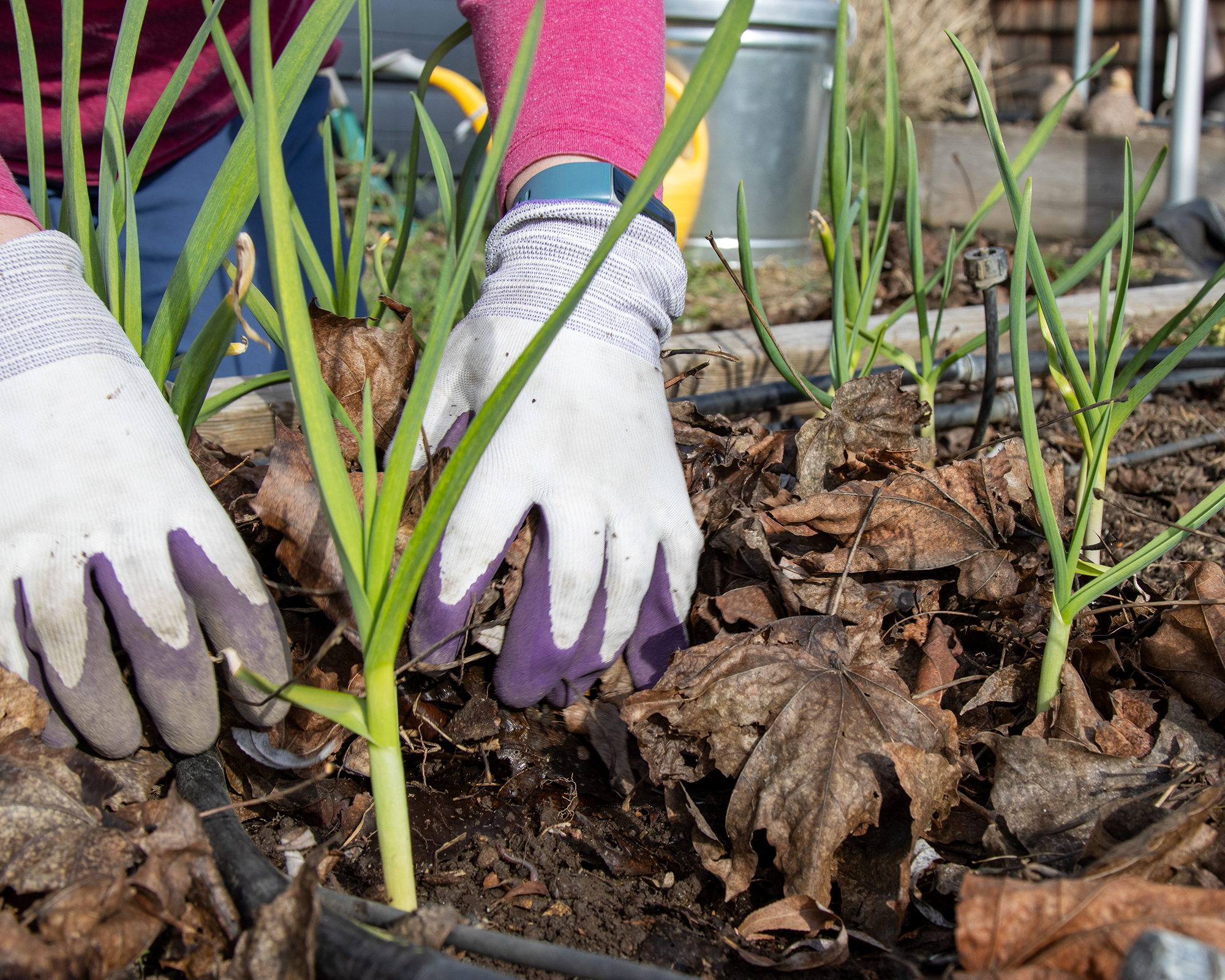When and How to Fertilize Garlic for Big, Healthy Bulbs
Garlic is a long-season crop that needs heavy fertilizing to grow big bulbs with the best flavor. Learn how to get the timing right and which products to use.

While it’s tempting to treat garlic as a plant-and-forget crop, it will only reward you richly if you treat it well. A clove planted in the fall won’t magically turn into a fat bulb by summer unless it has the nutrients it needs along the way. Using the right garlic fertilizer at the right time will make all the difference between weedy plants and large, flavorful bulbs.
Garlic is a surprisingly heavy feeder. That long growing season – often eight to nine months – means the plants steadily draw on soil fertility. Neglect fertilizer, and you could end up with small bulbs or yellowing foliage. However, overdo it and you’ll be left with soft bulbs that store poorly. A balanced approach is key.
If you’re just learning how to grow garlic, then knowing how to fertilize is a great place to start, as it will make a huge impact on crop quality. In this guide, you’ll learn how to choose the best fertilizer for garlic, when to apply it, and how to spot potential problems.
Why Garlic Needs Fertilizer
Garlic is not a crop that thrives in poor soil. It has a long growing season and high nutrient needs, which is why you’ll often hear gardeners call it a “heavy feeder.” Because bulbs take so long to come to fruition, it's best to think about feeding garlic plants right from the start.
When you plant a clove, it will set down roots in the cool months and then push out green shoots once spring arrives. These shoots allow it to build energy for bulb formation. Without steady nutrition, the bulbs won’t size up properly.

Best Fertilizer for Garlic Plants
Whatever types of garlic you are growing, the best fertilizer is one that provides plenty of nitrogen. This essential nutrient drives leafy green growth in spring, which later fuels bulb development.
If you’re growing organically, then opt for a natural product like blood meal, alfalfa meal, or fish emulsion. Otherwise, choose a balanced granular fertilizer, such as 10-10-10 – this Gardenwise 10-10-10 plant fertilizer, available from Amazon, is a slow-release formula that’s ideal to use when planting garlic.
Sign up for the Gardening Know How newsletter today and receive a free copy of our e-book "How to Grow Delicious Tomatoes".
When to Fertilize Garlic
Fertilizing garlic should be done in three stages. Ideally, feed once at planting, a few times through spring, and then only lightly in early summer, easing off before harvest.
1. At Planting Time
Soil preparation is the most important stage when fertilizing garlic. About six weeks before the ground freezes, or in mild climates from January to February, work compost or well-rotted manure into the top 6 inches (15 cm) of soil. This will also help improve drainage, which is important as garlic will struggle in soggy beds.
In addition to compost or mature, a light application of a balanced fertilizer at the time of planting helps establish strong roots.
Recommended soil amendments per 100 sq ft (9.3 sq m):
- Compost: 50 to 75 lbs (23 to 34 kg)
- Well-rotted manure: 40 lbs (18 kg)
- 10-10-10 fertilizer: 2 lbs (0.9 kg)
- Blood meal: 3 lbs (1.3 kg)
Soil preparing tip: Several weeks before planting, it’s a good idea to test soil pH using a home kit like the MySoil soil test kit from Amazon. A pH of 6.0 to 7.0 is ideal for garlic, so if your soil is more acidic or alkaline, then you will need to amend accordingly.

2. Spring Feeding
Starting in early spring, fertilize garlic every three to four weeks through the season using a high-nitrogen feed initially. Blood meal and fish emulsion work well – try The Grow Co’s organic fish emulsion fertilizer from Amazon.
3. Harvest Build-up
Do not fertilize garlic with high-nitrogen foods after May, as this may stunt the bulb size. In early summer, lightly side-dress with compost or use weakly diluted liquid feed.
How to Fertilize Garlic
There are different methods for applying fertilizer throughout the growing season, depending on the type of product:
- Side-dressing – Dig a row an inch (2.5 cm) deep, about 3 to 4 inches (7.5 to 10 cm), from the plant, then sprinkle in granular fertilizer and water in.
- Liquid feeds – Dilute according to package instructions and pour around the base of plants every few weeks in spring.
- Broadcasting – This involves spreading fertilizer over the whole bed. It works particularly well if you mulch afterward.
Topping off soil with a layer of mulch – whether straw, shredded leaves, or another material – helps conserve moisture and keeps nutrients from washing away. If you’re new to gardening, then learning how to mulch plants will make the world of difference.

Feeding Problems
It’s important to check plants occasionally to keep an eye out for common garlic problems. Fertilizing issues are easy to diagnose. Yellow leaves in spring are usually a sign of nitrogen deficiency – a dose of fish emulsion or a side-dress with blood meal can fix the problem.
If the bulbs seem small or fail to form properly, that can also be traced back to poor feeding. On the other hand, over-fertilizing, especially late in the season, encourages lush, soft growth that doesn’t cure well and may rot in storage.
Frequently Asked Questions
How often to fertilize garlic?
After the initial soil preparation and planting feed, most gardeners fertilize two to three times in spring, which works out as every three to four weeks. Always stop by early summer.
When should you stop fertilizing garlic?
Once the bulbs begin to swell and garlic scapes appear on hardneck types, it’s best to stop feeding. Continued fertilization at this stage can lead to soft bulbs that won’t store well.

Amy Grant has been gardening for 30 years and writing for 15. A professional chef and caterer, Amy's area of expertise is culinary gardening.
